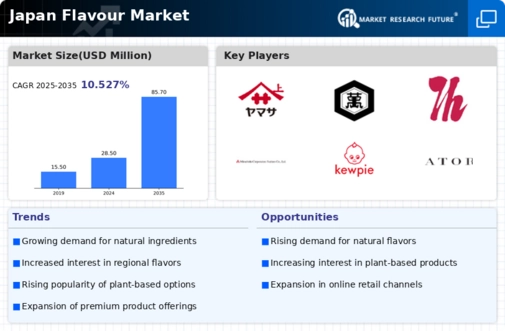The flavour market in Japan is characterized by a dynamic competitive landscape, driven by innovation, consumer preferences for natural ingredients, and a growing demand for unique taste experiences. Major players such as Givaudan (CH), Firmenich (CH), and T. Hasegawa (JP) are at the forefront, each adopting distinct strategies to enhance their market presence. Givaudan (CH) focuses on expanding its portfolio through strategic acquisitions and partnerships, while Firmenich (CH) emphasizes sustainability and natural sourcing in its product development. T. Hasegawa (JP), a local leader, leverages its deep understanding of regional tastes to innovate and cater to domestic preferences, thereby solidifying its competitive edge. Collectively, these strategies contribute to a moderately fragmented market structure, where innovation and consumer-centric approaches are pivotal in shaping competitive dynamics.
Key business tactics employed by these companies include localizing manufacturing and optimizing supply chains to enhance efficiency and responsiveness to market demands. The competitive structure of the flavour market in Japan appears to be moderately fragmented, with several key players exerting influence through their unique offerings and operational strategies. This fragmentation allows for a diverse range of products, catering to various consumer segments, while also fostering healthy competition among established and emerging players.
In September 2025, Givaudan (CH) announced a partnership with a leading Japanese beverage company to develop innovative flavour solutions tailored to local tastes. This collaboration is strategically significant as it not only enhances Givaudan's market penetration in Japan but also aligns with the growing trend of personalized consumer experiences. By leveraging local expertise, Givaudan is likely to strengthen its competitive position in a market that increasingly values authenticity and regional flavors.
In August 2025, T. Hasegawa (JP) launched a new line of natural flavourings derived from indigenous Japanese ingredients, aiming to capture the growing consumer preference for clean-label products. This initiative underscores T. Hasegawa's commitment to sustainability and innovation, positioning the company as a leader in the natural flavour segment. The strategic importance of this move lies in its potential to attract health-conscious consumers and differentiate T. Hasegawa from competitors who may not prioritize local sourcing.
In October 2025, Firmenich (CH) unveiled a new digital platform designed to enhance customer engagement and streamline the flavour development process. This digital transformation initiative reflects Firmenich's commitment to integrating technology into its operations, potentially improving efficiency and responsiveness to market trends. The strategic importance of this platform lies in its ability to foster collaboration with clients, enabling faster innovation cycles and a more agile response to consumer demands.
As of November 2025, current trends in the flavour market indicate a strong emphasis on digitalization, sustainability, and the integration of artificial intelligence in product development. Strategic alliances among key players are increasingly shaping the competitive landscape, facilitating knowledge sharing and resource optimization. Looking ahead, competitive differentiation is likely to evolve from traditional price-based competition towards a focus on innovation, technological advancements, and supply chain reliability. Companies that can effectively leverage these trends will likely secure a more robust market position in the future.





















Leave a Comment